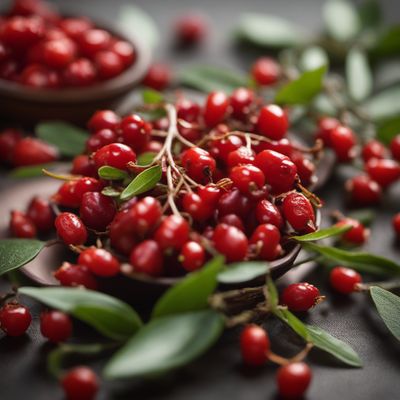
Ingredient
Gojiberry
Gojiberry: The Mighty Superfruit
Gojiberries are small, bright red berries that have a chewy texture and a subtly sweet and tangy flavor. They are often described as a cross between cranberries and cherries, with a hint of bitterness. These nutrient-dense berries are packed with antioxidants and are a great addition to both sweet and savory dishes.
Origins and history
Gojiberries have a rich history that dates back thousands of years in traditional Chinese medicine. They have been used to promote overall well-being, boost the immune system, and improve vitality. Native to China, gojiberries have been cultivated and cherished for their medicinal properties and unique flavor. Today, they are widely consumed and appreciated for their health benefits around the world.
Nutritional information
Gojiberries are a nutritional powerhouse, packed with antioxidants, vitamins, and minerals. They are a great source of vitamin C, vitamin A, iron, and fiber. These berries are also known for their high levels of antioxidants, which help protect the body against oxidative stress and promote overall well-being.
How to select
When selecting gojiberries, look for bright red berries that are plump and slightly soft to the touch. Avoid berries that are overly dry or have signs of mold or discoloration. Dried gojiberries are also available and can be a convenient option for longer shelf life.
Storage recommendations
To maintain the freshness and quality of gojiberries, store them in a cool, dry place away from direct sunlight. If you have purchased dried gojiberries, store them in an airtight container to prevent moisture absorption. Proper storage will help preserve their flavor and nutritional value.
How to produce
Gojiberries can be grown in your own backyard or garden with proper care and attention. They thrive in well-drained soil and require full sun exposure. Regular watering and pruning are essential for healthy growth. However, it is important to note that gojiberries may take a few years to produce a significant harvest.
Preparation tips
Gojiberries can be enjoyed in various ways. They can be eaten raw as a snack, added to smoothies, trail mixes, or oatmeal for a nutritional boost. Gojiberries can also be used in baked goods, such as muffins, cookies, or energy bars. Additionally, they can be infused in tea or used as a topping for salads or desserts.
Substitutions
Dried cranberries or cherries can be used as a substitute for gojiberries, although they may not provide the exact same flavor profile and nutritional benefits. Alternatively, you can use raisins or currants for a similar chewy texture in certain recipes.
Culinary uses
Gojiberries are commonly used in traditional Chinese cuisine, where they are added to soups, stews, and herbal teas. They are also used in desserts, such as gojiberry jelly, gojiberry-infused rice pudding, or gojiberry-filled pastries. In Western cuisine, gojiberries are often incorporated into smoothies, granola bars, and salads for their nutritional value and unique flavor.
Availability
Gojiberries are commonly cultivated in China, Mongolia, and the Himalayan regions. They are also grown in other countries, including the United States, Canada, and Europe. Additionally, dried gojiberries are widely available in supermarkets and health food stores around the world.



